#The Yule Lads
Explore tagged Tumblr posts
Text
All the reasons why Trevor is a bad character.
He threw rocks at birds, and celebrated when he hit one and knocked it down.
He kidnapped the Great Raven, threw him in a cage, and tortured him.
He accused Hilda of being a witch in front of their entire class.
He lied to his mum about what happened with the Great Raven, making himself out to be the victim.
He vandalized the Sparrow Scout's stall at the Trolberg Winter Festival.
He knocked over a pot of boiling hot vegetable broth right next to David and Frida.
He nearly took David's eye out by hitting him in the face with a snowball.
He has never shown the slightest hint of remorse for his actions.
As far as bullies go, Trevor has got to be the worst I've ever seen in a cartoon; which is saying something, considering how little screentime he has. He only has a speaking role in two episodes of Season 1, one episode of Season 2, and none in Season 3.
But what's really sickening is how many people pick up for this character. Animal abuse is one of the most objectively horrible things a bully can do; you think that would be enough for him to be universally hated. But some IDIOTS out there still proudly declare that he is their "favorite character"... and even go as far as to ship him with Hilda, or even David. People who he has done nothing but torment since he was introduced.
Seriously, in a show with so many great options to choose from (Hilda, David, Johanna, Twig, Alfur, etc.) what kind of MORON would choose Trevor as their favorite character!?!
Fuck Trevor, but fuck Trevor-stans especially. Trevor is NOT a tragic victim of child abuse. His mum pulling his ear is NOT a sign that she is abusive, it just means that she's strict. If anything, she coddles her son and enables his bad behavior. She believed his version of events as to what happened in Chapter 3: The Bird Parade without bothering to get Hilda's side of the story. Remember how smug Trevor looked when his mum accosted Johanna. Yeah; that should tell you all you need to know about his character.
I am really glad that Trevor did not get a redemption arc. He doesn't deserve one. He's a one-dimensional bully with ZERO redeeming qualities, who has NEVER felt any remorse for his actions. That is the reality of his character.
If David is the coolest kid in Trolberg (which he is) than Trevor is, without question, the nastiest kid in Trolberg. Fuck him.

#hilda#netflix#series#david#frida#trevor#redemption#season 3#series finale#season 1#season 2#The Bird Parade#The Troll Rock#The Yule Lads
14 notes
·
View notes
Text
the Winter Ones: Folkloric Figures of Winter, Yule, & Christmas
by Keziah
The winter holidays are ebbing ever closer for those of us in the Northern Hemisphere. With each passing year, more and more practitioners of witchcraft and/or followers of pagan paths have looked to taking up the customs of their ancestors or incorporating those customs into their practices in some way. Holidays have become a popular way of embracing such traditions, traditions that can make diasporic practitioners feel a little closer to home, traditions that can bring one nearer their ancestors, traditions that can aid in making one’s practice and customs truly unique to them.
Winter has many customs and traditions, and those practices differ from region to region. One of my favorite aspects of winter is the amount of figures associated with the season – folk figures unique to the regions from which they hail. For many people, if you ask them about figures they associate with winter, you’ll hear Father Christmas, Krampus, and maybe even a nod or two to Hans Trapp, but there are so many more winter figures out there! In this post, we’ll meet a variety of these folk spirits, and we’ll learn a bit about their tales. It’s my hope that readers of this blog may find a new way of incorporating beliefs or customs of their ancestors or of their homelands (for our readers who are members of diasporic populations), and that, in doing so, their winter holidays may be brighter for it. Now, shall we dive in? Who to meet first…
GRÝLA, JÓLASVEINAR, & JÓLAKÖTTURINN
Grýla, the Yule Lads, and the Yule Cat
(Icelandic Folklore)
A prominent feature in Icelandic Christmas and Yule folklore is the tale of a mountain-dwelling family that descends upon Icelandic communities during the Yule season, or during the 13 days leading up to Christmas. This family consists of –
Grýla – a large, frightening giantess, ogress, or half-troll/half-ogre (depending on what version of the tale you hear) who feasts upon naughty children;
Jólasveinar / the Yule Lads – Grýla’s thirteen thieving, tricksy sons;
and Jólakötturinn / the Yule Cat – Grýla’s pet cat, a massive, vicious, people-eating creature.
According to lore, throughout most of the year Grýla and her crew keep to themselves in some isolated mountainous area. If not in the mountains, it’s often said that Grýla and co. live in Dimmuborgir (lava formations in north Iceland). During the Yule or Christmas season, though, Grýla and her brood leave their domain behind to bring a bit of terror to the inhabitants of Iceland.
For thirteen nights, Grýla’s sons, the Yule Lads, will leave gifts for (and party with, play games with, and perform for) well-behaved children, and leave tricks or warnings for naughty children, but this version only came about after a shift in the tone of the tale. Most sources state that the Yule Lads were once purely horrible and simply wreaked havoc for the thirteen nights leading up to Christmas. Why the change? Well, apparently the original lore was so terrifying that the parliament of Iceland officially outlawed its use as a scare tactic against children. Thus, the brighter lore of playfully mischievous Yule Lads was born, differing greatly from the ‘creepy and revolting’ ways exhibited in the earlier tales.
As the stories go, one-by-one, the Yule Lads go into inhabited areas of Iceland and sow a little terror and chaos, each carrying out his own special form of mischief. They could only do their deeds at night, and were quite terrifying to behold – large, dirty, and ‘humanoid and bestial in equal measure’ (though now most depictions of the Yule Lads feature cheerful, bearded men with woolen clothes and pointed hats). The Yule Lads arrive (one per night) starting thirteen days before Christmas, and each continues their mischief spree for thirteen nights, only then departing (again, one per night).
The Yule Lads are:
Stekkjastaur ‘Sheep-Cote Clod’ – from the 12th - 25th of December, Stekkjastaur sneaks into pens and stables to harass sheep, attempting to suckle them all, though this is made difficult by his long, stiff, wooden legs, which don’t allow him to bend his knees and kneel on the ground.
Giljagaur ‘Gully-Gawk’ – from the 13th - 26th of December, Giljagaur hides in the gullies near homes until all the household has fallen asleep. Then, he makes his way to the cowsheds to steal milk.
Stúfur ‘Stubby’ –Stúfur will, from the 14th - 27th of December, steal into homes and nab anything leftover in the pans. Some versions say he steals the pan itself, for he likes to eat the ‘crust’ left behind on them from cooking.
Þvörusleikir ‘Spoon-Licker’ – from the 15th - 28th of December, Þvörusleikir sets about his diabolical task of breaking into homes and licking all the spoons (in particular, the wooden spoons).
Pottaskefill ‘Pot-Scraper’ – from 16th - 29th of December, Pottaskefill breaks into homes to steal unwashed pots so he can lick up all that’s left, be that the remnants of sauces, broths, and gravies, or leftover bits of food. He’s also said to eat any unfinished foods from plates.
Askasleikir ‘Bowl-Licker’ – from 17th - 30th of December, Askasleikir hides beneath beds, lying in wait for anyone to set their askur down. An askur is an Icelandic wooden bowl with a lid, which, according to these Yule tales, would sometimes be carried off to bed whilst one was enjoying a late-night snack. The bowl would then be placed on the floor beside the bed or just under the bed, where Askasleikir would be waiting to scarf down whatever is left in the askur.
Hurðaskellir ‘Door-Slammer’ – from 18th - 31st of December, Hurðaskellir starts his rounds, going around slamming doors. He finds it even more fun to do whilst everyone is sleeping.
Skyrgámur ‘Skyr-Gobbler’ – from 19th of December - 01st of January, Skygámur commits the heinous act of robbing any and every pantry or refrigerator he can find of skyr, a traditional Icelandic dairy food similar to yoghurt.
Bjúgnakrækir ‘Sausage-Swiper’ – as if Skyrgámur’s antics weren’t enough, Bjúgnakrækir is a rotten old sausage thief. He sits in the rafters of homes, waiting for everyone to go to bed or to look away. Then, he steals as many sausages as he can manage. Bjúgnakrækir makes his arrival on the 20th of December and leaves on the 02nd of January.
Gluggagægir ‘Window-Peeper’ – perhaps the creepiest of the lot thus far (though someone licking all the spoons is the stuff of nightmares), Gluggagægir makes his rounds from the 21st of December - 03rd of January, peeping through windows into homes, hoping to spy something to steal.
Gáttaþefur ‘Doorway-Sniffer’ – from the 22nd of December - 04th of January, Gáttaþefur, lured to your home by the scent of freshly baked laufabrauð (‘leaf bread,’ a traditional Icelandic Christmas bread), arrives to one’s doorway and will attempt to steal the laufabrauð.
Ketkrókur ‘Meat-Hook’ – from the 23rd of December to the 05th of January, Ketkrókur would find a way to steal the meat from your kitchen. He’d hide in the pantry, behind doorways, in the rafters, up the chimney, and he’d use his long, hooked staff, or meat hook, to quickly snatch away the meat either while it was being prepared or from the holiday table itself.
Kertasníkir ‘Candle-Stealer’ or ‘Candle-Beggar’ – from the 24th of December to the 06th of January, Kertasníker, the last of the Yule of Lads, steals candles, especially from children. Candles were once typically made from tallow and were edible, and some lore states that Kertasníker would steal the candles to snack on.
Nowadays, the Yule Lads are said to leave candies and small gifts for good children, placing the goods in the shoes that kids leave on their windowsills in hopes of finding them later filled with presents. Bad children, however, are said to be left nothing but rotten potatoes.
As for Grýla, well… Grýla comes and kidnaps naughty children, loading them into her sack and carrying them back to her husband, Leppalúði (who most sources say is quite lazy and prefers to stay in his cave than to go with Grýla and the Yule Lads to terrorize Icelandic children). Grýla and Leppalúði then eat the naughty children, cooking them up in Grýla’s giant pot or cauldron. Though Grýla and Leppalúði are known to have a particular fondness for eating children, some sources also warn that they’ll eat adults caught outdoors on their own during those long, dark winter nights.
If Grýla and her husband weren’t bad enough, you still have the Yule Cat to worry about, especially if you didn’t receive any gifts of new clothes for the holidays. It’s said that the Yule Cat, on Christmas night, eats anyone it catches that isn’t wearing at least one new item of clothing.
LA BEFANA
(Italian Folklore)
With particular association with Epiphany Eve (the night of the 05th of January), La Befana is witch in Italian folklore (sometimes called, fondly, the Christmas Witch). She’s said to fly around Italy on her broom on the night of Epiphany Eve, when she visits each household with children and fills each child’s stocking with gifts or punishments, depending on whether they were well or poorly behaved. Well-behaved children receive gifts and sweets, while those who were naughtier receive a coal lump, black rock candy, or a stick. Some tales also say that La Befana (who is obsessively tidy in some variations of her origin story) may sweep or clean your house before she leaves.
La Befana is said to be a very old woman with a cheerful, kindly disposition. She dresses simply, usually wearing a shawl either around her shoulders or tied over her hair (sometimes both), and her clothes are soot-covered, as the tales say she flies into each home via the chimney. She carries a wicker basket or cloth sack filled with all of the gifts and sweets she must deliver.
In some Italian regions, bonfires are burned on Epiphany, and those bonfires sometimes feature effigies of La Befana. Many people dress as La Befana at various Epiphany events and festivals in Italy.
ST. NICHOLAS & KRAMPUS
(Central European Folklore)
On Saint Nicholas Day (observed on the 5th or 6th of December, depending on the region), many children throughout Europe (and in diasporic communities around the world), wake up excited to check in their shoes or under their pillows for gifts from St. Nicholas. St. Nicholas, is a tall, lean, cheerful old man with a long white beard, usually depicted as being dressed in fine vestments, including a cape or chasuble, and almost always wearing an ornate miter atop his head. In Central European (and some Eastern European) folklore, though, jolly old St. Nicholas does not work alone.
The Krampus travels as Saint Nicholas’ companion. Usually depicted as a large red, black, or brown demon with cloven hooves and the legs and horns of a goat, pointed ears, a long, pointed or forked tongue, and a frightening, human face with a crazed or menacing expression, Krampus is truly the stuff of childhood nightmares. Saint Nicholas and Krampus make their rounds on Krampusnacht – the night of the 05th of December. While the well-behaved children received gifts from Saint Nicholas, naughty children meet punishment at the hands of Krampus. The punishment varies from one tale to the next – some say that Krampus switches the children with birch branches; some say that Krampus devours the children, often swallowing them whole; and still other tales say that Krampus nabs the children, loading them into the basket or pouch he wears upon his back and taking them to hell.

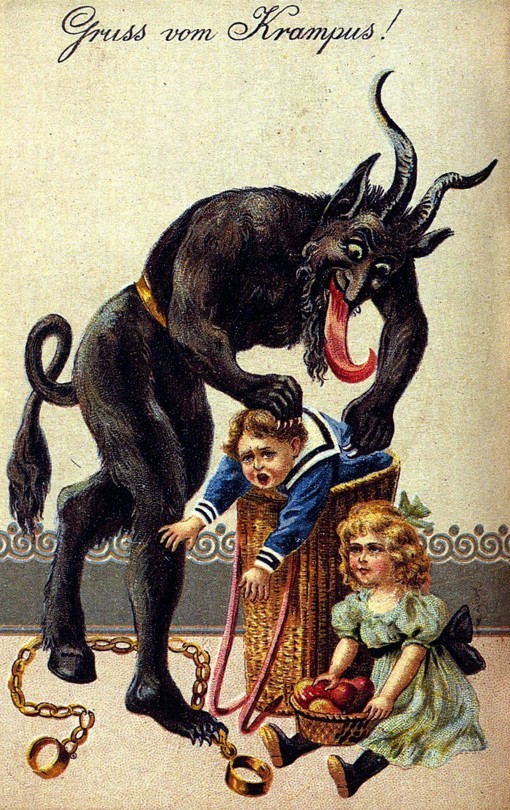
Despite attempts by the Catholic Church to ban Krampus, belief in the goat demon is very much still alive, with festivals and parades dedicated to Krampus, such as Krampuslauf, booming in popularity.
BELSNICKEL
(Germanic Folklore)
Belsnickel (also often spelled Belschnickel or Beltznickle) is a figure of Germanic folklore that finds its origins in Rheinpfalz, a historic region of Southwestern Germany. The belief in Belsnickel finds life still yet in some areas within this region, as well as in diasporic German peoples (and the descendants thereof) in Pennsylvania Dutch communities (birthed from settlers from the Rheinpfalz region) throughout the US.
Belsnickel is a man dressed in tattered, dirtied furs and clothes. In some versions, he also wears a mask with a long, pointed tongue. Belsnickel travels around at night (usually on the night of Christmas Eve), wielding a long switch in one hand and carrying a sack filled with cakes, candies, fruits, and nuts in the other hand or on his back. Poorly behaved children would receive a switching, while well-behaved children would be given sweets from the sack.
Brown’s Miscellaneous Writings features a first-hand account (having taken place around 1830) of one Beltznickel tradition from Maryland, USA –
‘One hand would scatter the goodies upon the floor, and then the scramble would begin by the delighted children, and the other hand would ply the switch upon the backs of the excited youngsters – who would not show a wince…’
In some Pennsylvania Dutch communities, it’s said that Belsnickel arrives one-to-two weeks before Christmas to ‘check in’ on how the children were behaving, punishing the bad children and serving as a frightening warning and reminder that they had better correct their ways before Christmas.
PERCHTA
(Alpine Folklore)
Known by many names, such as Pehta Baba (in Slovenian lore), Frau Perchta, and Frau Faste (in some Swiss and Slovenian lore), Perchta is a goddess associated with winter, spinning, and folk magic, particularly in Germany and Austria.
Perchta’s association with winter bears particular emphasis on midwinter and Twelfth Night. It’s said that Perchta would enter homes during the twelve days between Christmas and Epiphany, and she would dole out rewards and punishments. Children and servants of the home who had worked hard throughout the year and who had been good people would wake the next morning to find a small gift left by Perchta (usually a coin or trinket, though some modern customs say she may leave candies).
Her punishments, however, were far greater than her gifts. For children and servants who had been poorly behaved, unkind, and lazy, Perchta enters their bedrooms while they slumber, cuts them open, and replaces their stomach and guts with straw. Some tales say she does not replace one's entrails but simply fills the stomach with straw. It’s also said in some tales that Perchta delivers this same punishment to those who on the night of Perchta’s feast day eat something aside from the traditional foods of her feast day (those foods being fish and gruel).
Perchta’s association with spinning also comes into play in some variations of this tale, in which Perchta’s punishment is reserved for those who did not complete their spinning by the time of her visit. She was also said to trample or set fire to any half-spun fibers she discovered.
Perchta’s links to midwinter come from her ties to the legend of the Wild Hunt. Some tales of the Wild Hunt feature Perchta as the leader of the hunt.
As for Perchta’s appearance, there are two main versions. Perchta is sometimes described as a beautiful, young woman, with white or very pale hair and fair skin, usually dressed in white or silvery white hues. This Perchta differs greatly from that featured in some old depictions, which describe a hag woman dressed in rags, with a wrinkled face and a large beak-like nose made of iron. Some descriptions say this woman carries a cane, and many depictions feature her keeping a knife or blade beneath her skirts or robes.
The difference in these two depictions of Perchta is also reflected in the two variations of Perchten – a term that is used to apply to both the masks worn at festivals and processions honoring Perchta, as well as to figures associated with Perchta and seen as her subjects or helpers. Of these figures, there are two types –
Schönperchten: the beautiful, bright Perchten dressed in silvers and whites, said to deliver blessings of wealth and good luck during the Twelve Nights,
and Schiachperchten: the monstrously ugly Perchten with fangs and tusks, horns, tails, and beastly, fur-covered faces. The Schiachperchten are said to drive away evil spirits, ghosts, and demons.
SPILLAHOLLE
The Spillaholle – also known as Mickadrulle / Mickatrulle, Popelholle (‘Hooded Holle’), Zumpeldrulle – is believed to be a regional variation of Frau Holle or Perchta. She is said to be a very short old woman dressed in ragged, tattered clothing and a hood, and is, in some tales, said to carry stinging nettles with her.
The Spillaholle appears in towns and villages during winter, especially nearing Christmas or during the Twelve Nights of Christmas. The Spillaholle, who is strongly associated with spinning, is said to travel through town, peeking in the windows of each house to check to see ‘if the children and spinsters are spinning diligently.’ If their spinning hasn’t been taken care of by evening or nightfall, it’s said that the Spillaholle will dole out punishments. It’s even said that the Spillaholle will take the lazy spinsters away, beating them with the stinging nettles she carries with her. As for those who have finished their spinning, instead of a punishment, the Spillaholle leaves a blessing of protection – a single nettle is left upon the stoop or at the threshold of the home, a nettle that shall protect the house from various misfortunes for the next year.
MARI LWYD
(Welsh Folklore)
The origins of the Christmas tradition of the parading of the Mari Lwyd are up for debate. Some say it’s an early Christian practice, while many others believe that it’s a surviving pre-Christian tradition that’s been Christianized throughout the years. Believed to have come from a wassailing custom, the Mari Lwyd (said by some to mean ‘Grey Mary,’ ‘Holy Mary,’ or ‘Blessed Mary,’ and by others to mean ‘Grey Mare’) is a hobby horse, puppet, doll, or effigy that is paraded through town, carried from door-to-door by wassail-singing groups. This is done during the Christmas season, often ‘between Christmas Day and Twelfth Night.’
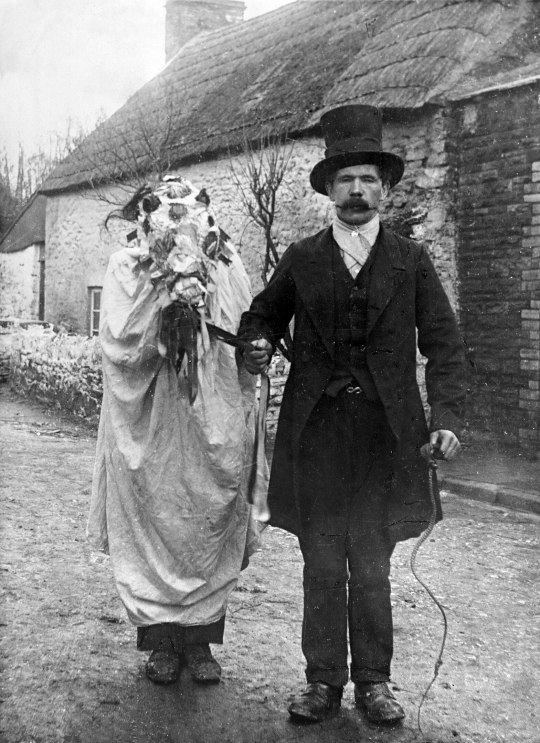
The head of the Mari Lwyd is usually a skull of a hoarse (and in most cases, the same skull is to be used each year), though there have been accounts of a head being carved from wood or shaped from a pillow. The skull (or makeshift horse head) is beautifully decorated with flowers and ribbons (the ribbons usually making up the Mari Lwyd’s mane), and has lights, baubles, or bottle glass for eyes. A white cloth is draped from the horse’s head down over the base of the Mari Lwyd, concealing the carrier of the doll underneath. A spring or stick is usually attached to the lower jaw of the skull, so that the jaw can be made to open and snap shut.
The parade is to begin at dusk or sundown. Singing and dancing is to be enjoyed whilst the Mari Lwyd makes her way along. At each door, the Mari Lwyd procession would perform traditional songs, and the household was to reply (usually through the closed door) with improvised, taunting poetry, usually delivering some kind of funny insult. A competition then ensues, a back-and-forth between the Mari Lwyd party and the household (this is a ritual called pwnco), until one side was bested and gave up, having no reply. Should the Mari Lwyd procession singers lose, they leave empty-handed. Mari Lwyd winning and entering the house, though, is believed to be a blessing that will bring good fortune to the household for the coming year.
The Mari Lwyd is said to be mischievous as well – chasing people, gnashing her jaws to scare children, and even trying to steal things or knock things about when she enters a home.
DED MOROZ & SNEGUROCHKA
(Slavic Folklore)

Ded Moroz (also called Dedushka Moroz – and other variations of Grandfather Frost – and Morozko) is familiar to many as Russian Santa, but Ded Moroz is much, much more than that. Ded Moroz finds his origins in pre-Christian Slavic paganism and folklore as a great magician and wizard of winter. Belief in Ded Moroz and customs surrounding him were banned during the early Soviet era. Nevertheless, Ded Moroz not only lives on, but has become a winter icon in East Slavic culture and is now the main figure associated with Novy God, the secular Christmas-like Russian celebration of New Year’s Eve and New Year’s Day.
Ded Moroz – a tall, old man with rosy cheeks and long white beard, who dresses in a floor-length fur coat and fur hat, and usually wields a magic staff – travels about (usually depicted travelling by a horse-drawn sleigh) delivering gifts to children. Some tales say that he delivers gifts all through December as well as on New Year’s Eve night, when he places the gifts under the New Year Tree whilst the household is sleeping.
One aspect of Ded Moroz’s tale that is rather unique is that of Snegurochka – Ded Moroz’s granddaughter who helps him make his deliveries. Snegurochka (also called Snegurka and the Snow Maiden), unlike Ded Moroz, doesn’t find her roots in pre-Christian Slavic lore, but rather in 19th century Russian fairytales. Snegurochka wasn’t depicted as Ded Moroz’s granddaughter until after 1935, when the holiday of Novy God was permitted by the Russia Federation. From then on, Snegurochka became Ded Moroz’s granddaughter and assistant, and has since been more commonly depicted as wearing wintery silver and blue cloaks and a fur hat (sometimes a crown made of glistening snowflakes).
SOURCES & FURTHER READING:
Þjóðsögur Jóns Árnasonar - the Collection of Folklore of Jón Árnason The Icelandic Yule Lads and their evil mother Gryla A Journey Around the Figure of the Befana – Manciocco, Claudia; Manciocco, Luigi Krampus | Definition, History, & Facts The Origin of Krampus, Europe's Evil Twist on Santa ‘the Krampus and the Old Dark Christmas: Roots and Rebirth of the Folkloric Devil’ – Ridenour, Al The Winter Goddess: Percht, Holda, and Related Figures: Folklore: Vol 95, No 2 ‘Deutsche Mythologie’ – Grimm, Jakob Holda: Between Folklore and Linguistics Who is Belsnickel in Pennsylvania German Christmas lore? ‘Brown’s Miscellaneous Writings’ – Brown, Jacob Yes Helen, there is a Belsnickel ‘A Dictionary of British Folk Customs’ – Hole, Christina The Mari Lwyd ‘Ritual Animal Disguise: A Historical and Geographical Study of Animal Disguise in the British Isles’ – Cawte, E.C. Mari Lwyd, a Welsh Christmas Tradition ‘A Tour Through Part of North Wales, in the Year 1798, and at Other Times’ – Evans, J. ‘Perchta the Belly-Slitter and Her Kin: A View of Some Traditional Threatening Figures, Threats and Punishments’ – Smith, John B. Felix und Ulrich Mueller - Percht und Krampus ‘the Old Magic of Christmas: Yuletide Traditions for the Darkest Days of the Year’ – Raedisch, Linda "Дед Мороз и Снегурочка" (Grandfather Frost and the Snow Maiden) –Dushechkina, E. B. ‘Encyclopedia of Russian & Slavic Myth and Legend’ – Dixon-Kennedy, Mike
#winter deities#winter spirits#seasonal witchcraft#winter#winter folklore#ded moroz#snegurochka#la befana#gryla#perchta#yule cat#the yule lads#mari lywd#st. nicholas#krampus#spillaholle#belsnickel#winter folk traditions#winter folk customs#mythology#folklore#the wild witch keziah#thewildwitchkeziah#yule#winter magic
5 notes
·
View notes
Text
Poll time!
#happy holidays#poll#tumblr poll#santa claus#la befana#krampus#gryla#the yule lads#perchta#belsnickel#tio de nadal#kallikantzaros#jólakötturinn#christmas spider
13 notes
·
View notes
Text
I love how, in any other kids show (and even in Season 1), The Yule Lads episode would be considered so random and chaotic, but since it was sandwiched in between The Deerfox and The Jorts Incident in the season with The Eternal Warriors, it felt underwhelming normal.
#if I had to pick a least favorite episode of the series it would be The Yule Lads#not because it’s bad or anything I actually really enjoyed it but because every other episode is even more amazing#like this show is what I would use to illustrate perfection#the only note I have is that I want more#there wasn’t a single episode I thought was just good#they were all just different levels of amazing#i love this show so much#hilda the show#hilda netflix#hilda the series#The Yule Lads#The Deerfox#The Jorts Incident#The Eternal Warriors
4 notes
·
View notes
Text




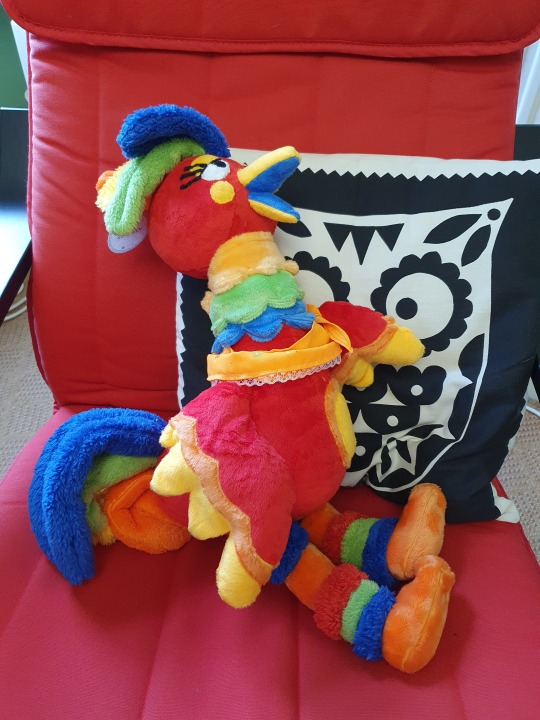
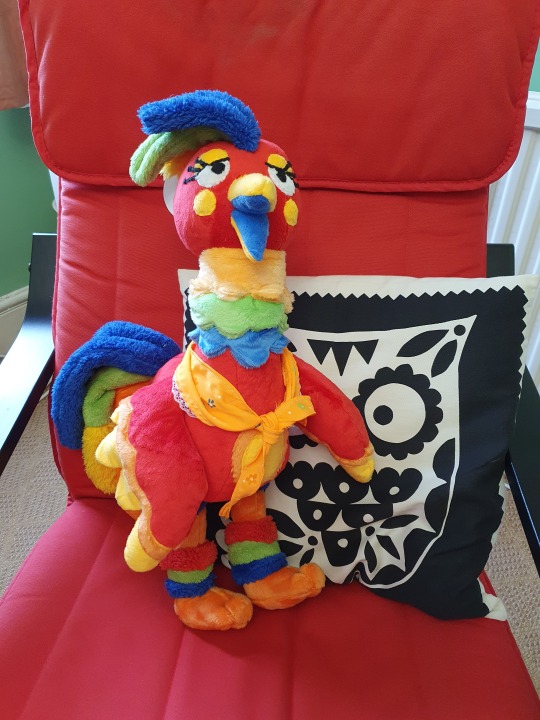
LADS IM FREAKING OUT my dear friend @cartoon-kitsune sent me a present and I was literally wearing this outfit when BAM. POPPY.
WE MATCH??? THE HAIR AS WELL this was not planned I can't. I can't believe how gorgeous she is or how funny it is that I'm literally the same colours rn THANK YOU SO MUCH KIT ;A;
also...

SHE BIG
#i LOVE HER AAAAAAA#also it's a one off commission dw lads we don't bootleg WH#BUT OH MY GOD AMAZING#Welcome Home#Poppy Partridge#I'm weeping crying sobbing my crops are flourishing#I am gonna hug her all day no more work just Poppy#(the jumper says Yule Got This bc im. cringe ok)#(I dress like a kid's TV presenter yes yes I've been told)
2K notes
·
View notes
Text
"You might not like that I'm still in Lazytown, but I promise you this. For as long as I'm here, you'll never have to spend the holidays alone."

-"You're insufferable." -"So I've heard." -"Do you plan on standing there the whole time, or are you going to sit and join me?" -"Whatever you like best." -"Don't play smart with me." -"But you love it when I do!" -"Ugh, just sit down already you sappy oaf!" . . .
Bonus!


Sportacus and Robbie as Yule lads to bless your day :) . . . Happy Holidays <3 <3
#digital art#clip studio paint#lazytown#sportacus#robbie rotten#christmas#general holiday festivities#yule lads
229 notes
·
View notes
Text
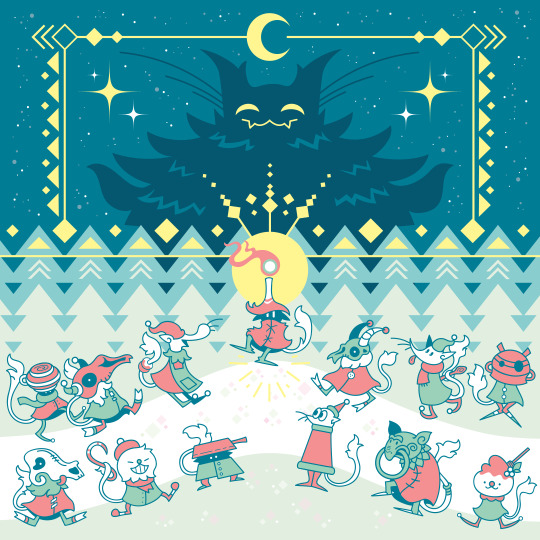
Yule Lads
700 notes
·
View notes
Text
Happy Yule to those who celebrate it, I’ve already left out some dried cranberries, mixed nuts, homemade chocolate chip cookies and dried oranges that I made for Odin, Krampus, the Yule Lads, Grýla, and Jólakötturinn (the Yule Cat) since I’m Icelandic. Also, gonna give some cookies or candy canes to Freyja, Loki, Hel, and Fenrir tomorrow! Blessed be.
#fyp#fypシ#fypシ゚viral#fypage#fyppage#tumblr fyp#witchcraft#witches#deity#deity work#norse deities#norse mythology#gryla#yule lads#jólakötturinn#krampus#freyja#loki#hel#fenrir#odin#yuletide#yule#offerings
134 notes
·
View notes
Text
Yule Cat

Image © PBS, by Samuel Allen. Accessed at his ArtStation here
[Part 3 of this year's Christmas series, following the Yule Lads and Grýla. I love this image; it's good at stressing that this is a giant domestic cat, not a "big cat" like a pantherine, indicates scale delightfully, and is a very recognizable feline behavior. Although in context, much more sinister. Bad kitty!]
Yule Cat CR 13 NE Magical Beast This creature resembles nothing so much as a fluffy domestic cat the size of an elephant. Its fur is gray with white mottling, and its eyes are wide and yellow.
Once upon a time, on a distant planet, a god of strength was challenged to perform seemingly simple tasks by a trickster titan. These tasks were all impossible but disguised with illusions, and one of them was to lift the giant’s cat—in actually, the Midgard Serpent, a primordial beast that encircles that globe. When the god tried to lift the serpent, and managed to get one paw off the ground, a kitten was born that was a metaphysical echo of the immovable cat. That kitten kept growing and growing the more she ate, until she was the size of a wagon. This is the Yule Cat.
The Yule Cat is a predator of small game, like any domestic cat, only due to the Yule Cat’s size, “small game” is Medium and Small humanoids. The Yule Cat prefers the taste of succulent young flesh, but hates the taste of newly made clothing. Thus, she preferentially attacks the impoverished and already suffering. In places where the Yule Cat roams, children are given gifts of clothing in the winter in order to make them less palatable to the great cat. The Yule Cat cannot be moved unless she wants to, and can be an impassible obstacle if she decides to set herself in front of a door or bridge and just wait for prey to pass by
The Yule Cat is “owned” by the fey troll Grýla, but like all cats, is as much an associate as a dependent. The Yule Cat stays in Grýla's cave for most of the warmer months and goes off hunting in the colder ones, but always manages to be by Grýla’s table in the winter to demand a portion of her finest human stews. Of Grýla’s children, the Yule Lads, she likes Stumpy the best, and will occasionally let him ride her. Rumor has it that the Yule Lads, Grýla and the Yule Cat once all lived on a distant world called Earth, but a ritual spell intended to force that darn cat to get up and move had the unforeseen consequence of sucking the whole monstrous clan through a portal and depositing them on Golarion. That said, the actions of gods and monsters can send distant ripples throughout the cosmos, and reports of “jotunn cats” may indicate that the Yule Cat is merely the most prominent member of a whole species.
Yule Cat CR 13 XP 25,600 NE Huge magical beast Init +10; Senses clothing sense,darkvision 60 ft., low-light vision, Perception +12, scent
Defense AC 28, touch 14, flat-footed 22 (-2 size, +6 Dex, +15 natural) hp 175 (14d10+98) Fort +16, Ref +15, Will +9 DR 15/magic; Resist cold 20, fire 20; SR 24 Defensive Abilities immovable
Offense Speed 50 ft. Melee bite +21 (2d6+9 plus grab), 2 claws +21 (1d8+9) Space 15 ft.; Reach 10 ft. Special Attacks pounce, rake (2 claws +21, 1d8+9), swallow whole (Medium or smaller, 2d6+13 bludgeoning, AC 17, 17 hp)
Statistics Str 27, Dex 23, Con 24, Int 8, Wis 17, Cha 12 Base Atk +14; CMB +24 (+28 grapple); CMD 40 (60 vs. bull rush, overrun, reposition, 68 vs. trip) Feats Acrobatic Steps, Combat Reflexes, Improved Initiative, Iron Will, Nimble Moves, Power Attack, Skill Focus (Perception) Skills Acrobatics +16 (+24 when jumping), Climb +17, Perception +12 (+8 if target is in new clothes, +16 if target is in old clothes), Stealth +12, Survival +6 (+2 if target is in new clothes, +10 if target is in old clothes); Racial Modifiers +4 Acrobatics, +4 Climb, +8 Stealth, +4 Perception and Survival if target is in old clothes, -4 Perception and Survival if target is in new clothes Languages Giant (cannot speak)
Ecology Environment cold mountains and forest Organization unique Treasure incidental
Special Abilities Clothing Sense (Su) The Yule Cat gains a +4 racial bonus on Perception and Survival checks to detect or track a target wearing clothing six months old or older, and can detect and pinpoint these creatures at twice the normal distance with scent. The Yule Cat also suffers a -4 racial penalty on Perception and Survival checks to detect or track a target wearing clothing a month old or newer, can only detect these creatures with scent at half the normal distance, and cannot pinpoint such targets by scent. Immovable (Su) The Yule Cat can become nearly impossible to move as an immediate action. When it does so, it freezes in place, even in midair, until it decides to move again. When frozen in this way, it can still attack, but cannot move from its square unless it chooses to render itself mobile as another immediate action. The Yule Cat gains a +20 racial bonus to CMD against bull rush, overrun, reposition and trip combat maneuvers (this bonus does not require an action to activate or deactivate).
55 notes
·
View notes
Text

#a bit of a throwback to season 2#i love those weird little guys#but they were unhinged#hilda the series#hilda netflix#yule lads#hilda season 2#hilda meme
250 notes
·
View notes
Text
The History of Santa Claus
Santa Claus—otherwise known as Saint Nicholas or Kris Kringle—has a long history steeped in Christmas traditions. Today, he is thought of mainly as the jolly man in red who brings toys to good girls and boys on Christmas Eve, but his story stretches all the way back to the 3rd century, when Saint Nicholas walked the earth and became the patron saint of children.
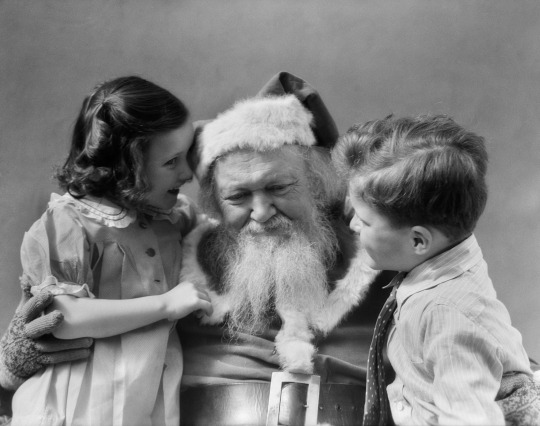
Santa Claus wasn't always "chubby and plump, a right jolly old elf." PHOTOGRAPH BY CLASSICSTOCK/CORBIS
The Legend of Saint Nicholas
The legend of Santa Claus can be traced back hundreds of years to a monk named St. Nicholas. It is believed that Nicholas was born sometime around A.D. 280 in Patara, near Myra in modern-day Turkey. Much admired for his piety and kindness, St. Nicholas became the subject of many legends.
One of the best-known St. Nicholas stories is the time three young girls are saved from a life of prostitution when young Bishop Nicholas secretly delivers three bags of gold to their indebted father, which can be used for their dowries. He was very religious from an early age and devoted his life entirely to Christianity. The strict saint took on some aspects of earlier European deities, like the Roman Saturn or the Norse Odin, who appeared as white-bearded men and had magical powers like flight. He also ensured that kids toed the line by saying their prayers and practicing good behavior. In continental Europe (more precisely the Netherlands, Belgium, Austria, the Czech Republic and Germany), he is usually portrayed as a bearded bishop in canonical robes.
During the Middle Ages, often on the evening before the anniversary of his death, December 6, children were bestowed gifts in his honour. By the Renaissance, St. Nicholas was the most popular saint in Europe. Even after the Protestant Reformation, when the veneration of saints began to be discouraged, St. Nicholas maintained a positive reputation, especially in the Netherlands.
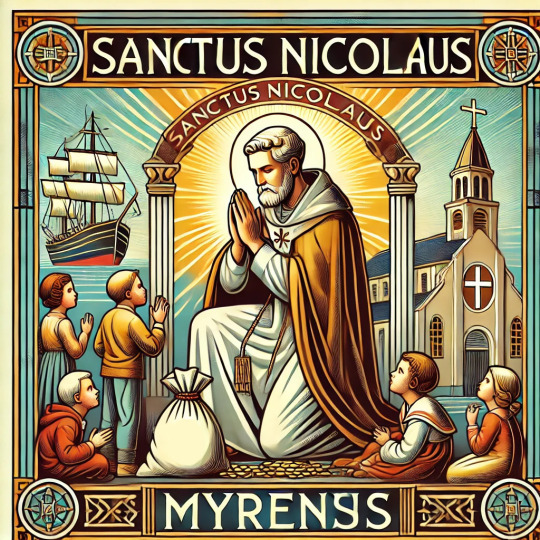
Coming to America
In the Netherlands, kids and families simply refused to give up St. Nicholas, or Sinterklaas as the saint is called in Dutch, as a gift bringer. They brought Sinterklaas with them to New World colonies. St. Nicholas made his first inroads into American popular culture towards the end of the 18th century. In December 1773, and again in 1774, a New York newspaper reported that groups of Dutch families had gathered to honor the anniversary of his death.
The name Santa Claus evolved from Nick’s Dutch nickname, Sinter Klaas, a shortened form of Sint Nikolaas (Dutch for Saint Nicholas). In 1809, Washington Irving helped to popularize the Sinter Klaas stories when he referred to St. Nicholas as the patron saint of New York in his book, The History of New York. As his prominence grew, Sinter Klaas was described as everything from a “rascal” with a blue three-cornered hat, red waistcoat, and yellow stockings to a man wearing a broad-brimmed hat and a “huge pair of Flemish trunk hose.” An appearance that was more derived from the English 'Father Christmas' and was quite different from the Dutch Sinterklaas.
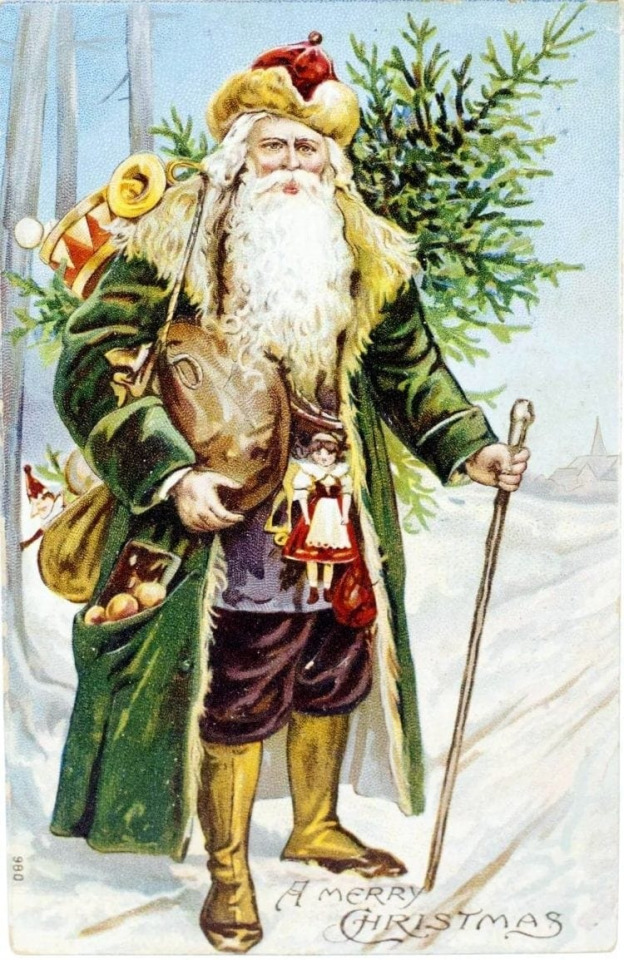
Santa Equivalents Around The World
Eighteenth-century America’s Santa Claus was not the only St. Nicholas-inspired gift-giver to make an appearance at Christmastime. There are similar figures and Christmas traditions around the world.
The English legend explains that Father Christmas visits each home on Christmas Eve to fill children’s stockings with holiday treats. Father Christmas dates back as far as 16th century in England during the reign of Henry VIII, when he was pictured as a large man in green or scarlet robes lined with fur. He typified the spirit of good cheer at Christmas, bringing peace, joy, good food and wine and revelry. As England no longer kept the feast day of Saint Nicholas on 6 December, the Father Christmas celebration was moved to 25 December to coincide with Christmas Day.
In the Netherlands and Belgium, the character of Santa Claus competes with that of Sinterklaas, based on Saint Nicholas. Santa Claus is known as de Kerstman in Dutch ("the Christmas man") and Père Noël ("Father Christmas") in French. For children in the Netherlands, Sinterklaas still remains the predominant gift-giver in December mostly celebrated on Sinterklaas evening the day before 6 December.
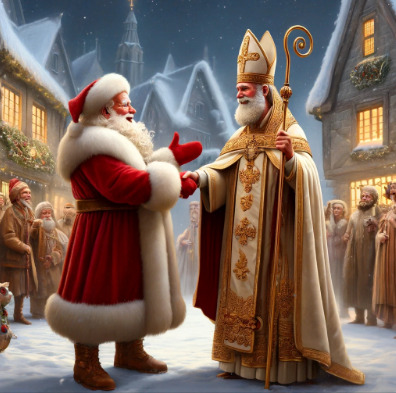
In Germany, the Christmas season is marked by the presence of two significant figures: Weihnachtsmann and Das Christkind or Christkind'l. Weihnachtsmann, a term that literally translates to "Christmas Man," is the German counterpart to Santa Claus. In contrast, Das Christkind, meaning "The Christ Child," represents a more traditional and religious aspect of German Christmas celebrations. Christkind was believed to deliver presents to well-behaved Swiss and German children on Christmas Eve. The name "Kris Kringle", a common variant of Santa in parts of the United States is derived from Christkind.
In Nordic folklore, the figure known as Tomte or Jultomten holds a special place in Christmas traditions. Originating from Swedish and Scandinavian mythology, Tomte is a small, mythical creature often depicted as a friendly, bearded being resembling a garden gnome and wearing a red cap. During the Christmas season, Tomte takes on a role similar to that of Santa Claus, delivering presents to children in a sleigh drawn by goats on the night of December 24th.
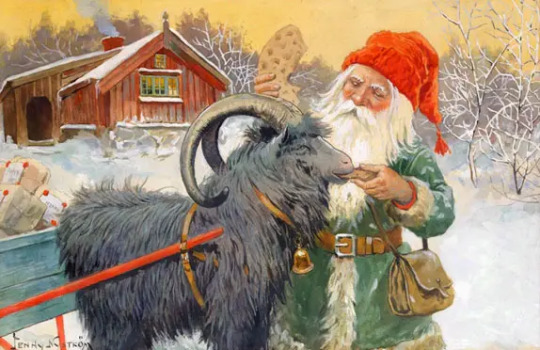
In Icelandic folklore, the Yule Lads, or "Jólasveinar," are mischievous characters associated with the Christmas season. These thirteen brothers, sons of the mountain-dwelling trolls Grýla and Leppalúði, are known for their playful antics and sometimes slightly sinister behavior. Traditionally, the Yule Lads would visit homes in the thirteen nights leading up to Christmas, each leaving small gifts or playing pranks depending on the behavior of the children.
In Italy, the Christmas season is marked by the presence of two iconic figures: Babbo Natale and La Befana. Babbo Natale, the Italian counterpart to Santa Claus, shares many similarities with the global image of the jolly gift-bringer. The other Italian icon, La Befana, is a unique and beloved figure in Italian folklore. Unlike the festive and plump Babbo Natale, La Befana is portrayed as an old woman, often depicted as a haggard but kind witch. According to tradition, La Befana visits homes on the night of January 5th, leaving small gifts and sweets for children who have been good and a lump of coal for those who have been naughty.
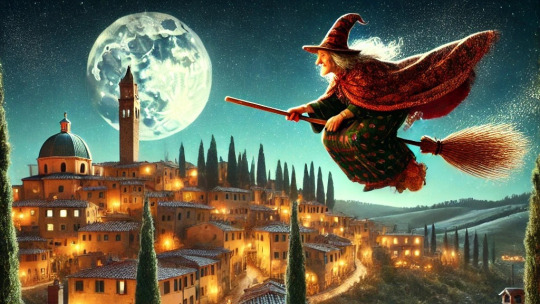
In French-speaking regions, the iconic figure associated with Christmas gift-giving is Père Noël, also known as Papa Noël. Père Noël is akin to the global representation of Santa Claus, often depicted as a jolly and benevolent character who travels in a sleigh pulled by reindeer, embodying the spirit of generosity and joy during the festive season.
In Spain and many Spanish-speaking cultures, the Christmas season unfolds with the anticipation of visits from both Papa Noel and Los Reyes Magos, offering children a delightful blend of traditions. Papa Noel, the Spanish equivalent of Santa Claus, is eagerly awaited on the night of December 24th. Following this, the celebration continues with the arrival of three kings known as “Los Reyes Magos” on January 6th. This holiday is known as Three Kings' Day or Día de Reyes. On the night before Día de Reyes, children place their shoes or small containers filled with hay under their beds for the Kings' camels. In return, Los Reyes Magos leave gifts, sweets, and small toys, creating a magical and cherished experience for children who wake up to the joyous surprises.
In Russia, instead of Santa, there is Ded Moroz and his granddaughter Snegurochka, who deliver gifts to children on New Year’s Eve. Children would sing Russian songs around the yolka.” A yolka is a coniferous tree similar to a Christmas tree. Ded Moroz is described as a grandfather with a long white beard.
Mikuláš (also known as Saint Nicholas) is the father of Christmas in the Czech Republic, as well as in Hungary. Mikuláš looks like the Pope and Santa combined. However Mikuláš is not always the person delivering presents on Saint Nicholas Day, it is typically believed to be Jesus. Saint Nicholas Day in the Czech Republic is predominantly celebrated on Dec. 5-6, although depending on the region, it is also celebrated on Dec. 25. Children put a boot out on the eve of Saint Nicholas Day and hope to find it full of candy and toys from Jesus in the morning. Bad kids can expect only a wooden spoon in their shoe.
In Japan Hoteiosho, or Hotei, is the equivalent of Santa pictured as a fat man with eyes in the back of his head who can tell if kids are naughty or nice. He is also known as the “Laughing Buddha,” because he is often depicted with a jovial face and surrounded by grinning children. Hotei is one of the Seven Lucky Gods, stemming from ancient Chinese and Indian religion. Hotei may have been based on a real person, named Budai, a man who died in 916 A.D. and was later worshipped in Buddhist practice.
So far a selection of customs and traditions similar to Santa Claus. Of course there are more, and in many traditions parallels to other cultures can be found.
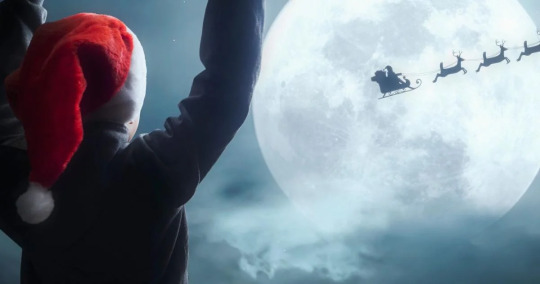
sources; history.com, nationalgeographic.com, wikipedia
#santa claus#saint nicholas#kris kringle#sinterklaas#father christmas#pere noel#papa noel#history#jultomten#christmas eve#december 6#december 24#yule lads#weihnachtsmann#christkindl
30 notes
·
View notes
Text
KARKAT: YOU’RE GAY FOR ONE OF US, YOU GOTTA BE GAY FOR ALL OF US. LIKE THE THREE MUSKETEERS.
VRISKA: Yeah, that’s how it works. It’s only fair.
#submission#source: Drawfee#specifically the Yule Lads and Porfmas Gifts stream#no idea for characters so the mods can pick#//#homestuck#incorrect homestuck quotes#karkat vantas#vriska serket#mod terezi#i went with the characters who have the weakest grasp on the concept of gayness but irradiate the strongest gay energy#you're welcome
100 notes
·
View notes
Text


growing my hair out again! 2025 resolutions:
do at least 10 push-ups and 10 squats every day no matter what
draw at least one thing in sketch book every day no matter what
pose only stupid for photos
11 notes
·
View notes
Text
The Yule Lads

Icelandic children get to enjoy the favors of not one but 13 Father Christmases. Called the Yule Lads, these merry but mischievous fellows take turns visiting kids on the 13 nights leading up to Christmas. On each of those nights, children place one of their shoes on the windowsill. For good boys and girls, the Yule Lad will leave candy. If not, the Yule Lads are not subtle in expressing their disapproval: They fill the shoe with rotting potatoes.
Don't think well-behaved Icelandic kids have a sweet deal all around, however. They may enjoy 13 Santa Claus-like visits, but they also have to contend with a creature called Grýla who comes down from the mountains on Christmas and boils naughty children alive, and a giant, blood-thirsty black kitty called the Christmas Cat that prowls around the country on Christmas Eve and eats anyone who's not wearing at least one new piece of clothing...
Meet the Thirteen Yule Lads, Iceland’s Own Mischievous Santa Clauses
59 notes
·
View notes
Text
Christmas Cryptid Drawing Challenge (ignore how I misspelled Gully Gawk)
#be more chill#h0n3yk1tt3n tiktoks#bmc drawfee#drawfee#yule lads#jenna rolan#rich goranski#michael mell#chloe valentine
8 notes
·
View notes